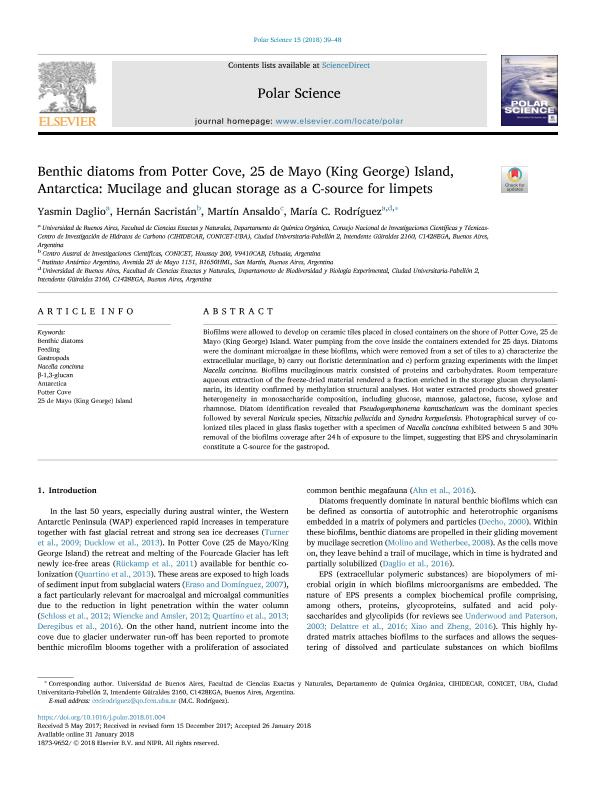Artículo
Benthic diatoms from Potter Cove, 25 de Mayo (King George) Island, Antarctica: mucilage and glucan storage as a C-source for limpets
Fecha de publicación:
03/2018
Editorial:
Elsevier
Revista:
Polar Science
ISSN:
1873-9652
Idioma:
Inglés
Tipo de recurso:
Artículo publicado
Clasificación temática:
Resumen
Biofilms were allowed to develop on ceramic tiles placed in closed containers on the shore of Potter Cove, 25 de Mayo (King George) Island. Water pumping from the cove inside the containers extended for 25 days. Diatoms were the dominant microalgae in these biofilms, which were removed from a set of tiles to a) characterize the extracellular mucilage, b) carry out floristic determination and c) perform grazing experiments with the limpet Nacella concinna. Biofilms mucilaginous matrix consisted of proteins and carbohydrates. Room temperature aqueous extraction of the freeze-dried material rendered a fraction enriched in the storage glucan chrysolaminarin, its identity confirmed by methylation structural analyses. Hot water extracted products showed greater heterogeneity in monosaccharide composition, including glucose, mannose, galactose, fucose, xylose and rhamnose. Diatom identification revealed that Pseudogomphonema kamtschaticum was the dominant species followed by several Navicula species, Nitzschia pellucida and Synedra kerguelensis. Photographical survey of colonized tiles placed in glass flasks together with a specimen of Nacella concinna exhibited between 5 and 30% removal of the biofilms coverage after 24 h of exposure to the limpet, suggesting that EPS and chrysolaminarin constitute a C-source for the gastropod.
Archivos asociados
Licencia
Identificadores
Colecciones
Articulos(CIHIDECAR)
Articulos de CENTRO DE INVESTIGACIONES EN HIDRATOS DE CARBONO
Articulos de CENTRO DE INVESTIGACIONES EN HIDRATOS DE CARBONO
Citación
Daglio, Yasmin; Sacristán, Hernán Javier; Ansaldo, Martin; Rodríguez, María C.; Benthic diatoms from Potter Cove, 25 de Mayo (King George) Island, Antarctica: mucilage and glucan storage as a C-source for limpets; Elsevier; Polar Science; 15; 3-2018; 39-48
Compartir
Altmétricas




